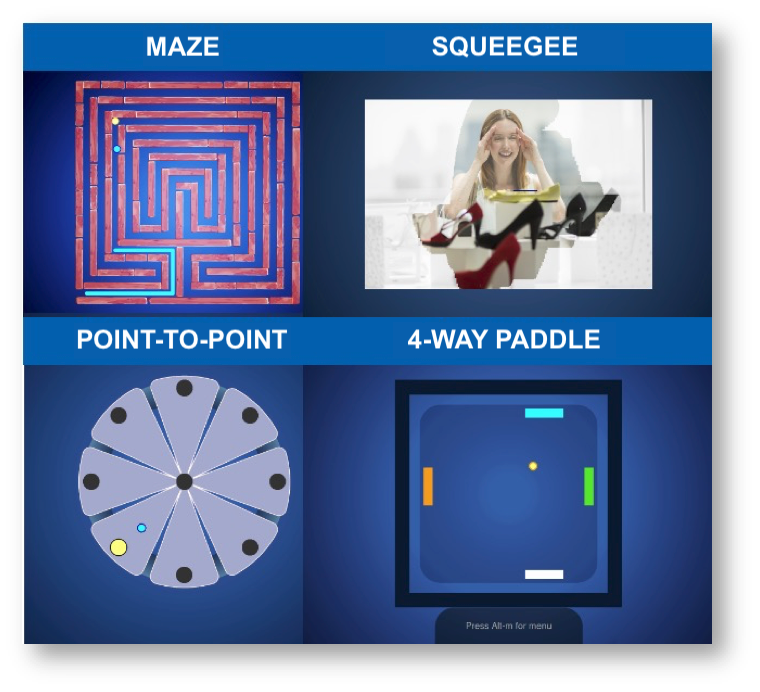InMotion® ARM for Neurological Rehabilitation
Robotic Assisted Shoulder & Elbow Therapy for Impairments from:
- Stroke
- Spinal Cord Injury
- Multiple Sclerosis
- Parkinson’s Disease
- Cerebral Palsy
and Other Neurological Conditions or Injuries
Rehabilitation Institutes Talk About their Experiences with the InMotion® ARM
InMotion® ARM — a New Generation!

InMotion® Interactive Therapy enables clinicians to efficiently deliver intensive motor therapy to help patients regain motor function following a neurological condition or injury. This new generation InMotion ARM® is an evidence-based neurorehabilitation technology that provides patients with real-time Assistance-as-Needed™. The InMotion ARM® quietly monitors the patient’s movements during therapy while it gently assists where needed to help them complete various motor therapy activities.
The InMotion® Robots are used for neurorehabilitation in over 20 countries, including the United States. Extensive research has shown InMotion® robots to be effective for wide range of motor impairments including: Stroke, Cerebral Palsy, Spinal Cord Injury, Multiple Sclerosis, Parkinson’s Disease, hemiplegic shoulder pain and muscle spasticity.
For more information, or to schedule an on-site demonstration of the New Generation InMotion ARM®, please email us at info@bioniklabs.com or call our U.S. office at (617) 926-4800.
InMotion® ARM is Here to Help!
- Task-specific training
- No active patient movement required
- Fast and efficient setup
- Easy-to-Learn / Easy-to-Use
- Evidence-based treatment protocols
- Over 1,000 movements per session
Designed for Efficiency
- 40% smaller footprint than the previous generation InMotion ARM®
- Wireless report printing – no cables crossing the floor!
- Easy patient start-up, easy to clean and easy to shut-down when done for the day


Simple Menu Options
Neurorehabilitation Simplified
Tailor motor therapy to the patient’s needs with adaptive therapy protocols and easy-to-use InMotion® Software:
- Simple menus
- Streamlined workflow
- Easy report generation
InMotion® ARM Therapy Tasks
Intensive — 1024 potential movements per therapy session with evidence-based treatment protocols.
Flexible — Therapy protocols allowing clinicians to customize treatment.
Therapeutic exercise for:
- Motor planning
- Eye-hand coordination
- Attention, visual field deficits/neglect
- Massed practice
By measuring patient kinematic and kinetic data objectively, BIONIK’s InMotion® Robots have shown that for severe to moderate brain injury the effectiveness of therapy is optimized by allowing the robots to focus on reducing impairment and allowing the therapist to assist on translating the gains in impairment into function.

Footnotes
- * Bosecker Caittlyn MS, Dipietro Laura, Volpe BT, Krebs HI “Kinematic Robot-Based Evaluation Scales and Clinical Counterparts to Measure Upper Limb Motor Performance in Patients With Chronic Stroke” Neurorehabilitation and Neural Repair 24(1) 62-69 , 2010.
- Robot training enhanced motor outcome in patients with stroke maintained over 3 years. Neurology. Volpe BT, Krebs HI, Hogan N, Edelsteinn L, Diels CM, Aisen ML. 1999;53:1874 –1876.
- Krebs, H.I., et al., “Rehabilitation Robotics: Pilot Trial of a Spatial Extension for MIT-MANUS,” Journal of NeruoEngineering and Rehabilitation, Biomedcentral, 1:5 (2004)Klein Julius, Spencer Steven J,Reinkensmeyer David J. “Breaking It Down Is Better: Haptic Decomposition of Complex Movements Aids in Robot-Assisted Motor Learning” ieee Transactions On Neural Systems And Rehabilitation Engineering, VOL. 20, NO. 3, MAY 2012
Krakauer John W, Carmichael Thomas S, Corbett Dale, Wittenberg George F, “Getting neurorehabilitation right: What Can Be Learned From Animal Models?” Neurorehabilitation and Neural Repair, published online March 30 2012
Dipietro, H.I. Krebs, B.T. Volpe, J. Stein, C. Bever, S.T. Mernoff, S.E. Fasoli, and N. Hogan “Learning, not Adaptation, Characterizes Stroke Motor Recovery: Evidence from Kinematic Changes Induced by Robot-Assisted Therapy in Trained and Untrained Task in the Same Workspace.” IEEE transactions on neural systems and rehabilitation engineering 2012 Jan:20(1):48-57